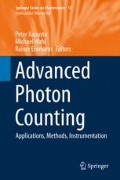Abstract
A method for a reliable quantitative analysis of fluorescence lifetime imaging microscopy (FLIM) data is presented. It is based on the linear unmixing of the intensity decay on the basis of selected reference patterns. This approach allows to use decays that are not mono-exponential without increasing the complexity of the analysis. This is a major benefit when working with labeled biomolecules or using autofluorescent cellular chromophores.
The method can be used intuitively and is fast. Furthermore, based on the reference patterns and the amount of recorded photons, one can easily determine confidence levels of the obtained results. We demonstrate that for a decomposition to three patterns of common chromophores, one achieves a standard deviation of better than 10% for as few as 1,000 photons per pixel, where the total amplitude of such a signal will show an error of 3% due to shot noise. Indeed, the accuracy of the results is very close to a maximum-likelihood estimator that defines the absolute limit for this kind of problem.
Access this chapter
Tax calculation will be finalised at checkout
Purchases are for personal use only
References
Harvey CD, Yasuda R, Zhong H, Svoboda K (2008) The spread of Ras activity triggered by activation of a single dendritic spine. Science 321(5885):136–140
Verveer PJ, Wouters FS, Reynolds AR, Bastiaens PIH (2000) Quantitative imaging of lateral ErbB1 receptor signal propagation in the plasma membrane. Science 290:1567–1570
Wouters FS, Bastiaens PIH (1999) Fluorescence lifetime imaging of receptor tyrosine kinase activity in cells. Curr Biol 9(19):1127–1130
Yasuda R (2006) Imaging spatiotemporal dynamics of neuronal signaling using fluorescence resonance energy transfer and fluorescence lifetime imaging microscopy. Curr Opin Neurobiol 16(5):551–561
Clayton AHA, Hanley QS, Verveer PJ (2004) Graphical representation and multicomponent analysis of single-frequency fluorescence lifetime imaging microscopy data. J Microsc 213(1):1–5
Digman MA, Caiolfa VR, Zamai M, Gratton E (2008) The phasor approach to fluorescence lifetime imaging analysis. Biophys J 94(2):L14–L16
Redford GI, Clegg RM (2005) Polar plot representation for frequency-domain analysis of fluorescence lifetimes. J Fluoresc 15(5):805–815
Lakowicz JR (2006) Principles of fluorescence spectroscopy, 3rd edn. Springer, New York
Walther KA, Papke B, Sinn MB, Michel K, Kinkhabwala A (2011) Precise measurement of protein interacting fractions with fluorescence lifetime imaging microscopy. Mol Biosyst 7(2):322–336
Kullback S, Leibler RA (1951) On information and sufficiency. Ann Math Stat 22(1):79–86
Lee DD, Seung HS (2000) Algorithms for non-negative matrix factorization. In: Leen TK, Dietterich TG, Tresp V (eds) Advances in neuronal image processing systems 13. MIT, Cambridge, pp 556–562
Neher RA, Neher E (2004) Applying spectral fingerprinting to the analysis of FRET images. Microsc Res Tech 64(2):185–195
Neher RA, Neher E (2004) Optimizing imaging parameters for the separation of multiple labels in a fluorescence image. J Microsc 213:46–62
Enderlein J, Sauer M (2001) Optimal algorithm for single-molecule identification with time-correlated single-photon counting. J Phys Chem A 105(1):48–53
Lawson CL, Hanson RJ (1974) Solving least squares problems. Prentice Hall, Englewood Cliffs
Isenberg I, Dyson RD (1969) The analysis of fluorescence decay by a method of moments. Biophys J 9:1337–1350
Acknowledgments
The authors thank Jörg Enderlein, Fred Wouters, Gertrude Bunt, and Benedikt Krämer for valuable discussions. The funding of the German Federal Ministry for Education and Research (BMBF) is gratefully acknowledged.
Author information
Authors and Affiliations
Corresponding author
Editor information
Editors and Affiliations
Rights and permissions
Copyright information
© 2014 Springer International Publishing Switzerland
About this chapter
Cite this chapter
Gregor, I., Patting, M. (2014). Pattern-Based Linear Unmixing for Efficient and Reliable Analysis of Multicomponent TCSPC Data. In: Kapusta, P., Wahl, M., Erdmann, R. (eds) Advanced Photon Counting. Springer Series on Fluorescence, vol 15. Springer, Cham. https://doi.org/10.1007/4243_2014_70
Download citation
DOI: https://doi.org/10.1007/4243_2014_70
Published:
Publisher Name: Springer, Cham
Print ISBN: 978-3-319-15635-4
Online ISBN: 978-3-319-15636-1
eBook Packages: Chemistry and Materials ScienceChemistry and Material Science (R0)

